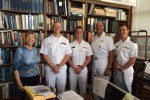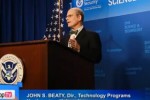News & Events
Transitioning Technology
Naval Academy Midshipmen Participate in ALERT Research July 1, 2015

Annapolis Naval Academy Midshipmen, Andrew Kelly and Gabe Lackey, are spending a month this summer doing ALERT research at the University of Rhode Island (URI), in Kingston, RI. Andrew and Gabe are Systems Engineering majors and have elected to use this time to work with the URI Energetic Materials Research Group. Their work includes hands-on experience with a myriad of aspects of explosives research at both the laboratory scale and in the field. Projects include using various instruments for physical characterization of both military explosives and homemade/improvised energetic materials.
Midshipman Lackey (pictured, middle) has said of his experiences,
“It has been very interesting to see the ‘behind the scenes’ process that takes an idea and eventually lets it reach the front lines, helping sailors, marines, and all military men and women.”
Midshipman Kelly (pictured, far right) says of his experiences working with ALERT scientists at URI,
“Working alongside the graduate students under Dr. Oxley has been informative in linking the numerous research areas to future military application, as well as what is currently being used.”
ADSA12 Presentations Now Available June 10, 2015
We are pleased to announce that the ADSA12 Workshop presentations are now available for download at the following link:
https://alert.northeastern.edu/transitioning-technology/adsa/final-reports-and-presentations/
If you have any questions regarding the topics and technologies discussed at the workshop, please contact Carl Crawford at [email protected].
ALERT leads Tutorial at IEEE Symposium on Technologies for Homeland Security April 16, 2015

ALERT led one of two tutorials given at the 2015 IEEE Symposium on Technologies for Homeland Security on April 14th, 2015. The tutorials launched a three day event which included a plenary talk by Dr. Reginald Brothers, the Under Secretary of Homeland Security for Science and Technology, and four research tracks focused on key homeland security topics:
- Cyber Security,
- Attack and Disaster Preparation, Recovery, and Response,
- Land and Maritime Border Security
- Biometrics & Forensics.
The tutorial provided an introduction to explosive threat sensing technologies to over 25 representatives from educational institutions, national labs, DHS, and members of the private security industry.
ALERT Director, Prof. Michael Silevitch began the session by providing an overview of ALERT’s mission, research areas, industrial partnerships, and current technology transition efforts. After a brief Q&A, Jim Smith from the University of Rhode Island discussed how chemicals are classified as explosives and methods of trace detection. Dr. Smith presented what explosives tend to be found in improvised explosive devices and URI’s work in improving the detection of these types of materials. ALERT’s work in vapor detection, explosive residue detection, and canine explosive detection were all discussed.
For the second half of the tutorial, Prof. Octavia Camps presented techniques used within the video analytics domain to detect features, descriptors and invariants (fixed components) in video. She then discussed the process of inference used to classify video data. All of these components are in play in ALERT’s video analytic work. Octavia reviewed the VAST project, a collaboration with Siemens, the TSA and Cleveland Hopkins International Airport, by discussing the project’s contraflow (in-the-exit) and tracking in a crowded scene (tag and track) components. Prof. Camps also discussed ALERT’s partnership with VACCINE and the GCRTA to improve detection of known criminals within the rail system through video re-identification.
Carl Crawford closed the session with a presentation on X-ray based and millimeter wave detection technologies. After discussing the history of threats to air travel and current scanning processes, Dr. Crawford covered how false alarm rates are a substantial barrier to current technologies and what ALERT and its partners are doing to lessen its impact. ALERT technologies including detection diffraction systems, real time tomography systems, and active millimeter wave systems were presented by Dr. Crawford. ALERT’s work with third parties such as national labs, DHS security vendors and other academic intuitions to improve scanning rates and generate non-SSI research datasets were also highlighted.
The diverse audience engaged with center representatives regarding current ALERT partnerships, available research datasets, and in the field research projects. The tutorial included a productive discussion on the barriers of transitioning technology and opportunities for future collaborations in the tutorial’s domain. ALERT looks forward to continuing to support the Homeland Security Enterprise through events such as the IEEE Symposium.
New England Cable News (NECN) Interviews ALERT Researcher, Prof. Carey Rappaport, on Breast Imaging Research October 26, 2014

Prof. Carey Rappaport, ALERT researcher in the College of Engineering at Northeastern University, was recently interviewed by the New England Cable News about his team’s microwave breast imaging research for safer breast cancer screenings. Watch the interview below:
ALERT Renames the ADSA workshops August 13, 2014

We are pleased to announce the renaming of the ADSA workshops from “Algorithm Development for Security Applications” to “Advanced Development for Security Applications.” This change reflects the fact that the scope of these workshops has expanded well beyond algorithms as the series has progressed.
For example, the following topics for development are now being addressed in these workshops: energy sources (e.g., X-ray, neutrons), sensors (e.g., photon counting X-ray detectors, trace), concept of operations, hardening, deterrence, simulants and testing. The acronym for the workshops, ADSA, will remain the same.
The Eleventh ADSA Workshop (ADSA11) has been scheduled for November 4th and 5th at Northeastern University in Boston, MA. The title of the workshop will be “Explosive Detection in Cargo for Aviation Security – Part II.”
RI Senator Jack Reed Visits ALERT at URI February 25, 2014

FROM URI NEWS, KINGSTON, RI – February, 25, 2014 — U.S. Sen. Jack Reed met Monday with University of Rhode Island professors from chemistry, engineering and cyber security to see firsthand some of the leading research they are conducting on explosives, explosives detection, and cyber security, and discuss efforts to strengthen URI’s role in physical and cyber security study.
During a campus tour yesterday with Gerald Sonnenfeld, URI vice president for research and economic development; Jimmie Oxley, URI professor of chemistry and director of the U.S. Department of Homeland Security Center of Excellence in Explosives, Detection, Mitigation, and Response at the University of Rhode Island; Otto Gregory, URI distinguished professor of engineering and co-director of the Sensors and Surface Technology Partnership; Lisa DiPippo, associate professor of computer science and the academic director of the Cyber Security Program at URI; Alan Davis of the Naval Undersea Warfare Center in Newport; and URI students, Reed observed demonstrations of some of the work URI is doing to improve security, detect explosives and neutralize their impact, and strengthen the nation’s cyber security capabilities.
[Photo Credit: URI Photos by Michael Salerno Photography.]
VAST program featured on fedscoop.com February 14, 2014

TSA Federal Security Director Michael Young honors ALERT August 28, 2013

On Wednesday, August 28, ALERT researchers and personnel were honored with the presentation of an award by Ohio Transportation Security Administration Federal Security Director, Michael Young for ALERT’s efforts in the Video Analytic Surveillance Transition (VAST) project. The presentation, followed by a luncheon, was also attended by the Northeastern University Senior Vice Provost, Mel Bernstein, the Dean of Northeastern University’s College of Engineering, Nadine Aubry, and TSA Program Analyst, Edward Hertelendy.
ALERT’s VAST project, conducted in partnership with Siemens Corporate Research, TSA and Cleveland Hopkins International Airport (CLE) is developing video analytics methods at CLE to address existing airport security concerns. As explained by ALERT director Michael Silevitch, “the ability to access real time data from the Cleveland airport enabled the ALERT researchers to test their methods and optimize performance. That, coupled with the collaboration of our industrial partner Siemens, was essential in terms of developing tools that would be of practical use to people in the field.”

TSA Award Presentation to ALERT. From left to right: Michael B. Silevitch, David Castanon, Octavia Camps, Edward Hertelendy, John Beaty, Michael Young, Carey Rappaport.
Taking a moment to recognize the partnership between ALERT and the TSA, Dean Aubry expressed that ALERT is a model center to the College of Engineering. “We are really proud to be able to do user inspired research, but the challenge is to take that research and to apply technology transfer in order to really make an impact on society and the security of our airports, and that’s what you are doing”. In her closing remarks the Dean emphasized the value of the collaboration for both academia and industry.
Senior Vice Provost Bernstein reminded the attendees that the award ALERT was being honored with was not only an award about the outstanding work being done, but also for the commitment to the mission of advancement for the common good. “The model program between ALERT and the Cleveland airport is really quite impressive,” he said. “The fact is that this may not have been the easiest thing to do, but it really speaks to the opportunity, talent, the willingness of the Northeastern side, and the understanding that TSA has to be able to make this kind of investment. This is really what we had hoped would happen in the early days of DHS, and this is one great example”.
Michael Young, while presenting the award to the ALERT team, mentioned the recent successes of the VAST partnership, and the notability of the project through both industry and academia. He briefly explained his history with the ALERT Center of Excellence and noted that this award is really about collaboration. The award states on it, “In recognition of your technological research and innovation in support of TSA-Cleveland in the development of advanced algorithms for CCTV Surveillance Systems”. Director Young then proceeded to present the ALERT team with TSA Challenge Coins to show appreciation and recognize the work and support of each individual team member.
This award reflects ALERT’s ability to make a positive impact on critical problems faced by the Homeland Security Enterprise. ALERT looks forward to continuing this valuable partnership with the Transportation Security Administration through years to come.
Banner and Side Bar Photo Credit: Craig Bailey/Perspective Photo
August 1st at 1pm EDT – Technologies for Bomb Response Twitter Chat August 1, 2013

DHS S&T will be hosting a twitter chat on Technologies for Bomb Response today at 1pm EDT. Those of you that are interested can follow the conversation at https://twitter.com/dhsscitech or at #STTechTalk.
The First Responders Group, with support from the Explosives Division and the DHS Office for Bombing Prevention, is hosting a Twitter Chat August 1 from 1:00-2:00 pm EDT. The topic is Technologies for Bomb Response, and the discussion will feature the Semi-Autonomous Pipe Bomb End-Cap Remover (SAPBER), FiRST App (a smart phone application for bomb response), and more!
A Twitter Chat is a virtual, two-way conversation that allows us to reach out to targeted audiences, ask for their feedback on S&T products/services, and answer their questions. We encourage our Twitter followers to tweet (message) us during the Chat so we can provide real-time responses. Twitter users can follow the full conversation using our hashtag (#STTechTalk), a designated word that links tweets from S&T and from participants.
Read MoreProf. Carey Rappaport Highlighted on Northeastern University’s Website for ALERT Airport Security Research July 18, 2013

Prof. Carey Rappaport and his ALERT research team were highlighted on Northeastern University’s webiste, in a section titled “Making Tomorrow Happen,” for their research in airport security. To learn more and read the article, visit NEU’s website:
Read More
